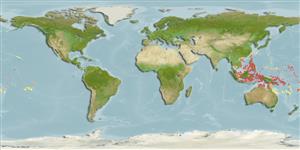Environment: milieu / climate zone / depth range / distribution range
Ecologia
marinhas associadas(os) a recifes; intervalo de profundidade 0 - 12 m (Ref. 9710). Tropical
Western Central Pacific: Indonesia, New Guinea, Solomon Islands and Palau in Micronesia.
Tamanho / Peso / Idade
Maturity: Lm ? range ? - ? cm
Max length : 11.0 cm TL macho/indeterminado; (Ref. 48636)
Espinhos dorsais (total): 12; Raios dorsais (total): 17-19; Espinhos anais 2; Raios anais : 17 - 20. Identified by the red spots over the back and sides towards the tail, and the large breast spot (Ref. 48636).
Facultative air-breathing (Ref. 126274); Adults are found solitary on coral outcrops (Ref. 90102). They inhabit shallow lagoon reefs, on algal covered rocks and rubble (Ref. 9710). Feed on algae growing at the coral bases. Oviparous. Eggs are demersal and adhesive (Ref. 205), and are attached to the substrate via a filamentous, adhesive pad or pedestal (Ref. 94114). Larvae are planktonic, often found in shallow, coastal waters (Ref. 94114). Maximum depth reported by Ref. 48636.
Ciclo de vida ou comportamento de acasalamento
Maturidade | Reprodução | Desova | Ovos | Fecundidade | Larvas
Oviparous, distinct pairing (Ref. 205).
Myers, R.F., 1991. Micronesian reef fishes. Second Ed. Coral Graphics, Barrigada, Guam. 298 p. (Ref. 1602)
Status na Lista Vermelha da UICN (Ref. 130435)
Ameaça para os humanos
Harmless
Uso pelos humanos
Mais informação
ReferênciasAquaculturaPerfil para aquaculturaEstirpesGenéticaElectrophoresesHereditariedadeDoençasProcessamentoNutrientsConversão de massa
ColaboradoresFotosStamps, Coins Misc.SonsCiguateraVelocidadeTipo de nataçãoÁrea branquialOtólitosCérebrosVisão
Ferramentas
Relatórios especiais
Baixar XML
Fontes da internet
Estimates based on models
Preferred temperature (Ref.
123201): 27.4 - 29.3, mean 28.8 °C (based on 1360 cells).
Índice de diversidade filogenética (Ref.
82804): PD
50 = 0.5001 [Uniqueness, from 0.5 = low to 2.0 = high].
Bayesian length-weight: a=0.01072 (0.00480 - 0.02393), b=3.01 (2.82 - 3.20), in cm total length, based on LWR estimates for this (Sub)family-body shape (Ref.
93245).
Nível Trófico (Ref.
69278): 2.0 ±0.00 se; based on food items.
Resiliência (Ref.
120179): Elevada, tempo mínimo de duplicação da população menor que 15 meses (Preliminary K or Fecundity.).
Fishing Vulnerability (Ref.
59153): Low vulnerability (10 of 100).
Nutrients (Ref.
124155): Calcium = 131 [70, 225] mg/100g; Iron = 0.891 [0.529, 1.461] mg/100g; Protein = 18.4 [17.2, 19.5] %; Omega3 = 0.125 [0.075, 0.206] g/100g; Selenium = 20.7 [11.5, 39.8] μg/100g; VitaminA = 113 [33, 391] μg/100g; Zinc = 2.5 [1.7, 3.6] mg/100g (wet weight);
